This is Not a Test: The Coronavirus Pandemic
March 18, 2020
The Trump Administration released new guidelines on Sunday March 17th to curb the spread of the coronavirus disease (COVID-19), calling for people to avoid social gatherings of more than 10 people, steer clear of bars and restaurants, and attend work or school from home if possible. President Trump announced, “If we do a really good job,” the United States can limit the death toll of the virus. These regulations, put in place in an attempt to contain exponential growth into a plateau of cases, while strict, are not mandatory. How do these new guidelines compare to how other countries have handled the virus?
The trend of exponential growth and then an eventual plateau and decline of cases is apparent especially in Eastern countries: China, Japan, Taiwan, South Korea, Singapore, Thailand, which have managed to “flatten the curve” of the number of COVID-19 cases. These countries have had experience with lethal infectious disease. When they were hit with a SARS outbreak in 2003, they learned how viral and dangerous contagion can be and how to stop its spread effectively.
Additionally, the cultural difference between these eastern countries and the Western countries governs the way different countries respond to the outbreak. The virus is taken much more seriously in Eastern countries. In Singapore, a methodic technological system has been put in place to deal with this emergency, but citizens are also asked to do their part. In India, everyone, even the poorest rickshaw driver, has made alterations in their lives to combat the virus. Regardless of the country’s wealth, information about the virus is a country’s best weapon. The more information available to the public about the severity of the outbreak and how best to prevent its spread, the more successful a country will be. The COVID-19 outbreak has been mostly the subject of jokes and levity in the US and other western countries. The seriousness in Asia is mainly due to the divide between the developed and developing world. If poverty and disease are a daily presence in your life, then you are prepared for your world to fall apart at any moment. You are better equipped to handle life threatening situations.
This is why the graphs of Asian countries, despite starting to grow much earlier, do not appear to be exponential, but plateau. What have they done specifically to contain the virus?
China in particular implemented aggressive measures to control the spread of COVID-19, which proved to be effective in preventing the exponential trajectory which is taking over the US, Italy, and other western countries. On January 21st, there were about 1500 cases in China. On January 23rd, two days later, government officials shut down Wuhan. At this point, they believed there were 400 cases in that particular city. In reality there were about 2500 cases, yet, chinese officials still made the decision to shut down Wuhan completely. The next day, 15 more cities were shut down.
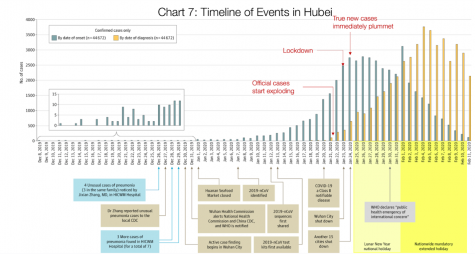
A timeline of events in Hubei details how the number of cases rises, and then eventually plateaus after cities are put on lockdown. Up until January 23rd the number of new cases daily was exploding exponentially. As soon Wuhan was shut down completely, the number of cases paused, and on January 24th, when 15 more cities were shut down, the number of true cases plummeted. The rest of China followed suit and took immediate and drastic measures to prevent the spread of the virus.
Two widely used apps in China, AliPay and WeChat, used a “traffic-light system” to keep track of each person’s movements and health status, helping enforce restrictions. The government can watch an infected person’s movements and determine whether the virus is being transmitted elsewhere. These measures worked. Once a person was infected, the infected person rarely spread the virus elsewhere apart from their own family members. The line of transmission stops here because the virus has nowhere else to go. With early aggressive measures coupled with extreme social distancing: the cancellation of public events and small group activities, China appears to have been able to successfully contain the virus.
Of course, electronic surveillance and forcibly locking people into their own homes is unrealistic in a free democratic society, but China’s efficient response to the outbreak is something to be replicated, especially the construction of makeshift hospitals. China finished building an emergency hospital to treat persons affected by COVID-19 in just ten days. The key to constructing hospitals at such fast speed is using prefabricated units, which are prepared offsite at another factory that the same time the foundation is built at the site of the hospital. This way the structure and the foundation of the hospital can be built in parallel. On March 9th, China closed its last makeshift hospital, a sign that China’s efforts to prevent the spread of COVID-19 were effective.
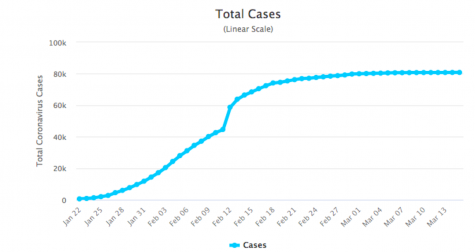
The graph above of China’s total COVID-19 cases, reveals the efficiency of China’s actions against COVID-19.
The number of cases grew exponentially until China contained it, but then it leaked outside of China. Now there are many countries, most of them western, with exponential growth rates. Of course, with China’s intrusive social control and government surveillance, it is not realistic for the US and other countries to contain the virus the same way China did. However, it is still possible to prevent the spread of COVID-19 through aggressive social distancing in a free society. Singapore, Hong Kong, and Taiwan are perhaps more instructive examples. All three countries, each with different socioeconomic and political structures, were successful in containing the virus. Their success suggests that other governments can do the same.
South Korea has also been extremely successful in containing the virus. Interestingly, unlike China and other countries, South Korea has managed to curb the spread of COVID-19 without a complete lockdown, but through intense testing. Testing is readily available, with about 20,000 people getting tested for COVID-19 daily. An impressive 250,000 tests have been ordered. People in South Korea can be tested in drive-through clinics, which reduce risk for health workers.

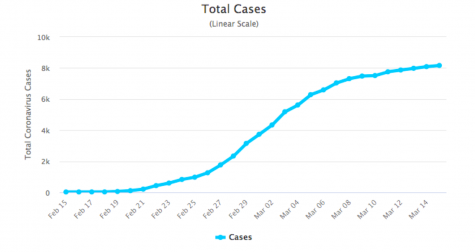
The graph of South Korea’s total COVID-19 cases above displays the exponential increase and eventual plateau of cases from February 15th to March 14th.
Let’s take a look at Italy. On Sunday March 15th, Italy recorded the biggest one day increase in cases and deaths during the entire outbreak: 3590 cases and 398 deaths, a 59.2% increase from the previous high of 250 deaths a day. Italy’s experience has demonstrated the importance of early and intense action against COVID-19. What is the difference between Italy and China? Why was Italy hit so hard?
The answer is multifaceted. The main reason is that they did not implement draconian measures early or aggressively enough. In less than a month, Italy has gone from having just three cases to having the highest number of cases and deaths outside of China, with at the time of writing 2,158 deaths and 27980 cases, and expects some 90,000 infections by the end of April. The first case in Italy was detected on February 20th. On March 9th, Italy declared a lockdown with upwards of 9,172 cases.
China put Wuhan and 15 other cities on lockdown when they believed there to be only 400 cases in all of China, while Italy implemented a lockdown when there were 9,172 cases of COVID-19. The difference is time: when aggressive but necessary actions such as lockdown, social distancing, and testing are taken, determines the trajectory of the viruses’ spread and determines whether the curve will flatten out, or continue growing exponentially.
Italy’s total number of COVID-19 cases is still on the upswing, and shows no sign of stopping. It has been almost a month since the first case of COVID-19 arrived in Italy, but the graph continues to rise indefinitely:
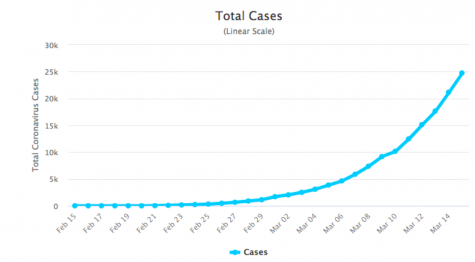
The United States is at a critical inflection point in the COVID-19 outbreak. We have the same number of cases Italy had two weeks ago. The US will either follow South Korea, which implemented drastic mitigation efforts and curbed the spread of the virus, or Italy, which is facing an exponential increase in the number of cases and deaths from COVID-19. Is it too late for Italy and the US to make our graphs like those of China and South Korea?
Looking at a graph of the total number of cases in the US:
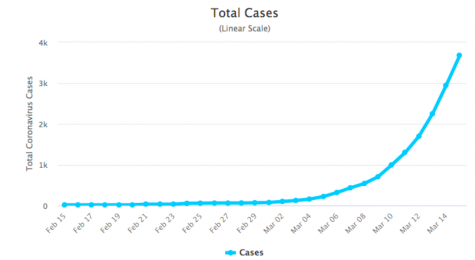
As predicted, this too is an exponential growth curve.
How can we flatten the curve and curb the exponential growth of cases in the US? Well, for one, we can take notes from South Korea and test as many people as possible. A graph of COVID-19 testing per capita shows how far behind the US has fallen in testing.
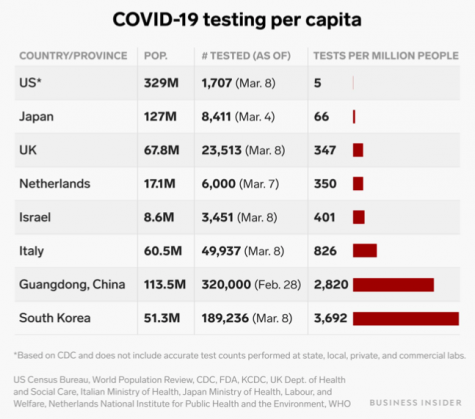
As of March 13th, a total of 25,000 tests have been conducted nationally, compared to 20,000 tests conducted in South Korea daily. Without adequate testing, it is difficult for health officials to determine the death rate or the virus, and the scope of the outbreak’s spread. It also is impossible to know how many Americans are infected with COVID-19.
However, there are local locations where infected people can get tested. Penn Medicine will be opening two ambulatory testing sites beginning on Monday March 16th. These sites offer drive-through testing. These sites are located at 201 King of Prussia Road in the North Parking Lot and 4122 Market Street Parking Lot in West Philadelphia.
On March 17th, the United States has just begun lockdown in certain areas with upwards of 4597 cases nationally. California announced the complete lockdown of the Bay Area, while New York, Los Angeles and Washington state have all announced public buildings will be shut temporarily. At this point in time, we are following in Italy’s footsteps.
A myth has been circulating that face masks do not protect the wearer from the virus. If someone is wearing a mask in the US, it is assumed that they are sick, not that they are trying to protect themselves against the virus. In China and other eastern countries, however, wearing masks is a civic duty. The difference again is cultural. Asian countries value the community over the individual, and wearing a mask ensures that if someone has the virus then the chain will end there. To them, it is a simple and necessary action which can prevent many infections. To us, there is a stigma associated with wearing masks, that the wearer must be sick. What is a medical decision in eastern countries, is a social decision in western countries. Wearing a mask can also draw unwanted attention, and even make the wearer a target. This coupled with government officials and surgeons telling the public that masks should only be worn by health officials, is preventing the citizens of the United States from curbing the spread of COVID-19. Of course masks help. While not perfect, they offer another layer of protection against viral droplets.
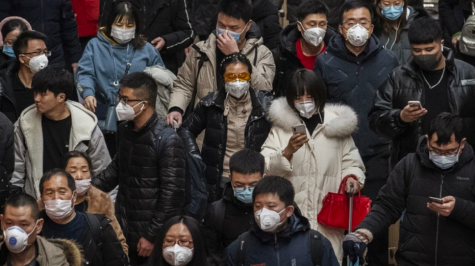

Another way to contain COVID-19 is by practicing social distancing. The principle is that with exponential growth an epidemic action such as social distancing taken early on can have a much greater impact than if the same actions are taken even a day later. Take a look at this graph:
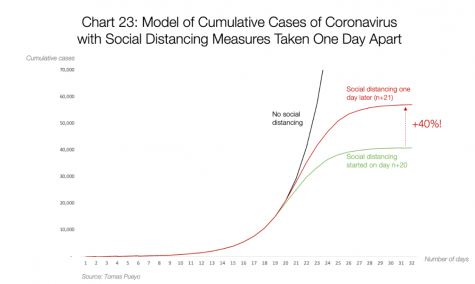
Social distancing actions measures taken one day apart result in a 40% reduction of cases. This underscores the urgency of the situation and how we can benefit from acting quickly and efficiently.
In just one or two weeks the US will either be Italy or South Korea, and it all depends on how the public responds and if we all practice social distancing aggressively. Any gathering, no matter the size, is dangerous because of how easily COVID-19 is transmitted. People may be asymptomatic or might have recently contracted the virus, so they may not be aware that they have the virus and are contagious. The best thing we can do today is stay away from others as much as possible. Quarantining is the most effective measure that we can practice.
This is not a snow day, or an early vacation. There is a reason school, weddings, and social gatherings have been cancelled and we must respect these safety measures so we can “flatten the curve” and prevent the exponential spread of COVID-19. No social gathering: playdates, sleepovers, or parties or family friend visits should be allowed. This may seem extreme, but even with contact with one other person, you are creating links for transmission that our school/work/public event closures are trying to prevent. We don’t know who could be infected, or who has had contact with an infected person, which is part of the reason why this virus is so problematic. Social distancing is not a suggestion.
As young people, we think that it doesn’t really matter if you get sick or carry the virus. It is true that people over the age of 60 are at the most risk and the majority of infections are mild. But if you contract the virus, you will transmit it to people at risk or the elderly—something that is scarily easy to do, since many cases are asymptomatic but contagious (per a new study in Italy).
This outbreak is not about the individual, but the population as a whole. There is a scary shortage of ventilators and beds across America. It’s capacity is already extremely low—about 100,000 ventilators for the entire country. Millions of Americans are expected to be infected. A study of the 44000 cases in mainland China show that 19 percent of people suffered from pneumonia or worse-cases that require hospitalization. This equates to hundreds of thousands of people requiring hospitalization in the US, maybe even million depending on the infection rate. If we go about having fun as kids, we risk infecting more people all at once, flooding our healthcare system. To reduce risk, we must think about ourselves within a community, and how our actions will affect others. This means social distancing as much as we can and self-isolating if someone presents with symptoms of COVID-19.
It is predicted that 2.2 million people will die from COVID-19 without measures. Maybe we should not accept such a high death rate and instead decide it is not too late to follow China, South Korea, Singapore and other countries which controlled their infections. We can only do this with extreme measures, and our country has come nowhere near what is necessary in containing the spread of COVID-19. The sacrifice will be huge—complete lockdown, universal facemasks, rigorous testing—but necessary. At this point, the US is not doing enough. The experiences of Italy and China and South Korea have demonstrated the importance of immediate and draconian actions, and we must learn from them. It may be too late, but we have no choice but to try.
Sources:
https://www.nytimes.com/2020/03/13/science/COVID-19-math-mitigation-distancing.html
https://time.com/5799586/italy-COVID-19-outbreak/
https://medium.com/@tomaspueyo/COVID-19-act-today-or-people-will-die-f4d3d9cd99ca
https://www.cbsnews.com/news/COVID-19-us-cases-south-korea-italy-surgeon-general-jerome-adams/
https://www.cnn.com/2020/03/13/americas/COVID-19-us-italy-south-korea-lessons-intl/index.html
https://www.worldometers.info/COVID-19
https://www.cdc.gov/COVID-19/2019-ncov/cases-updates/testing-in-us.html
https://www.nytimes.com/2020/03/17/opinion/COVID-19-face-masks.html
https://time.com/5799964/COVID-19-face-mask-asia-us/







Mohinder Sood • Mar 19, 2020 at 1:38 pm
Commendable.